Analysing Barriers to Change and Leadership in M&S: A Report
VerifiedAdded on 2020/06/03
|9
|2469
|447
Report
AI Summary
This report examines leadership and change management within Marks & Spencer (M&S). It begins by identifying barriers to change, such as fear and ineffective communication, and how these influence leadership decisions. The report then utilizes force field analysis to identify driving and resisting forces within M&S, analyzing their impact on decision-making. It evaluates the use of force field analysis in achieving organizational objectives. The study further explores various leadership approaches – including autocratic, consultative, and democratic styles – and their application in dealing with change within M&S. The effectiveness of these approaches in delivering organizational change is evaluated, along with a critical assessment of leadership models. The report concludes by emphasizing the significance of effective leadership in navigating change and suggests a combination of leadership approaches for successful organizational transformation at M&S.
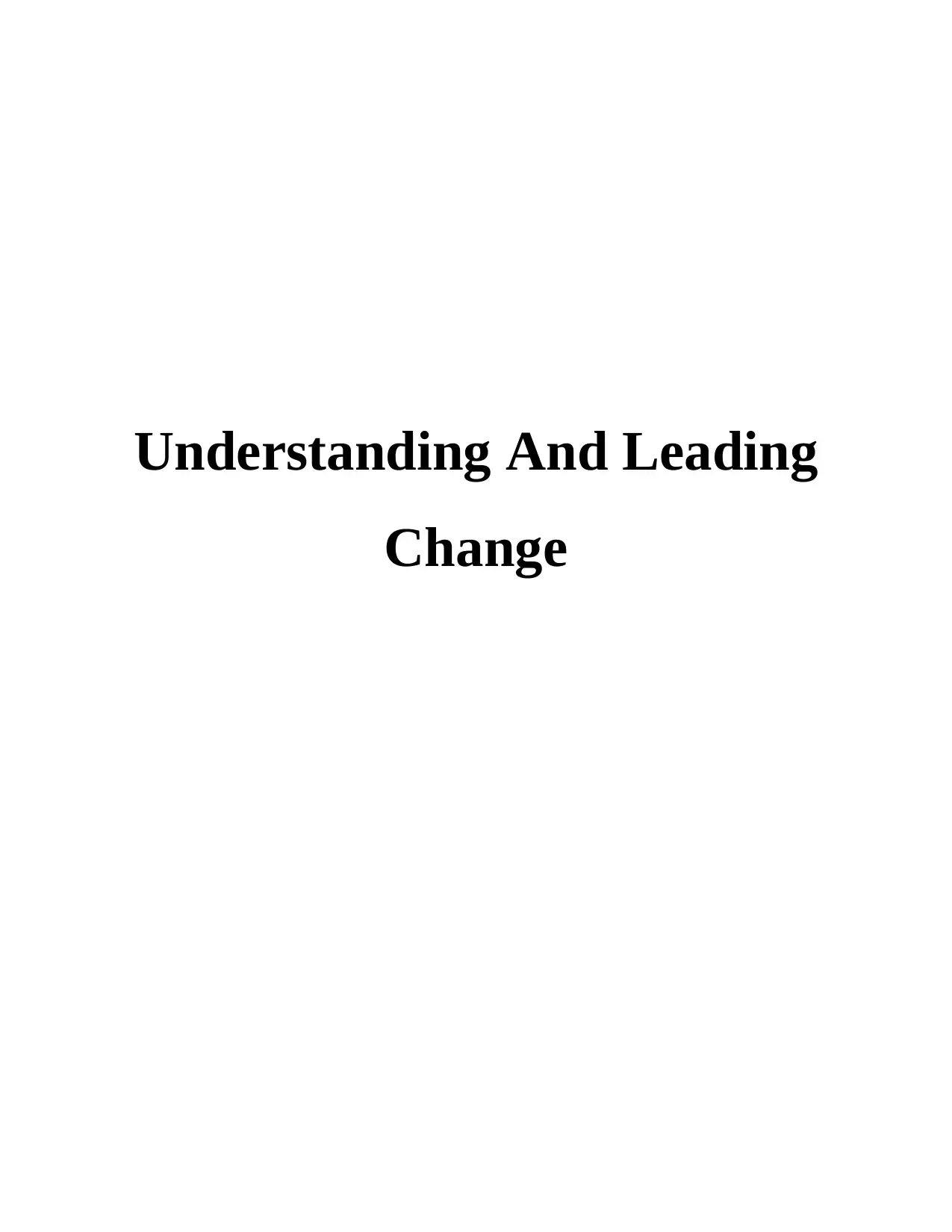
Understanding And Leading
Change
Change
Paraphrase This Document
Need a fresh take? Get an instant paraphrase of this document with our AI Paraphraser
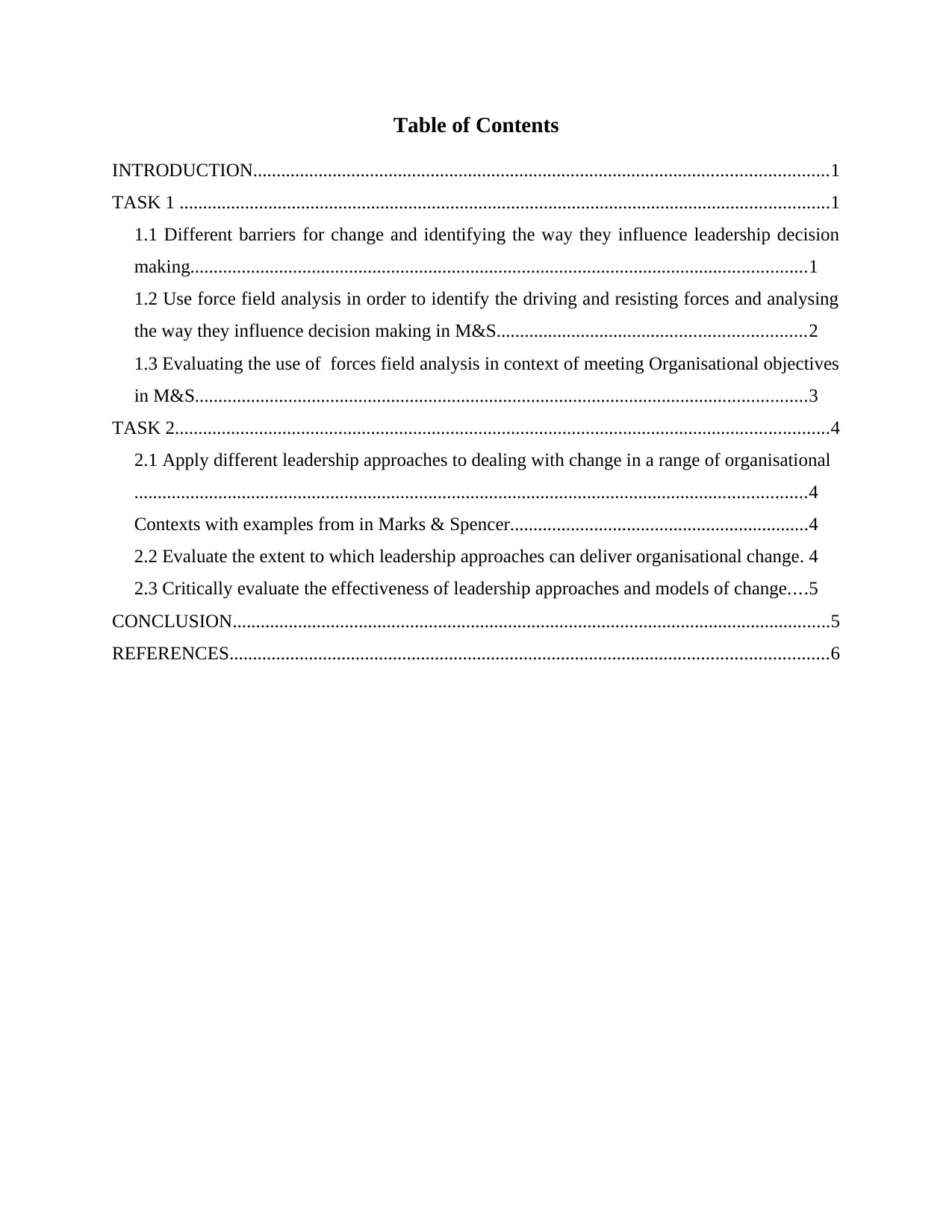
Table of Contents
INTRODUCTION...........................................................................................................................1
TASK 1 ...........................................................................................................................................1
1.1 Different barriers for change and identifying the way they influence leadership decision
making....................................................................................................................................1
1.2 Use force field analysis in order to identify the driving and resisting forces and analysing
the way they influence decision making in M&S..................................................................2
1.3 Evaluating the use of forces field analysis in context of meeting Organisational objectives
in M&S...................................................................................................................................3
TASK 2............................................................................................................................................4
2.1 Apply different leadership approaches to dealing with change in a range of organisational
................................................................................................................................................4
Contexts with examples from in Marks & Spencer................................................................4
2.2 Evaluate the extent to which leadership approaches can deliver organisational change. 4
2.3 Critically evaluate the effectiveness of leadership approaches and models of change....5
CONCLUSION................................................................................................................................5
REFERENCES................................................................................................................................6
INTRODUCTION...........................................................................................................................1
TASK 1 ...........................................................................................................................................1
1.1 Different barriers for change and identifying the way they influence leadership decision
making....................................................................................................................................1
1.2 Use force field analysis in order to identify the driving and resisting forces and analysing
the way they influence decision making in M&S..................................................................2
1.3 Evaluating the use of forces field analysis in context of meeting Organisational objectives
in M&S...................................................................................................................................3
TASK 2............................................................................................................................................4
2.1 Apply different leadership approaches to dealing with change in a range of organisational
................................................................................................................................................4
Contexts with examples from in Marks & Spencer................................................................4
2.2 Evaluate the extent to which leadership approaches can deliver organisational change. 4
2.3 Critically evaluate the effectiveness of leadership approaches and models of change....5
CONCLUSION................................................................................................................................5
REFERENCES................................................................................................................................6

⊘ This is a preview!⊘
Do you want full access?
Subscribe today to unlock all pages.

Trusted by 1+ million students worldwide
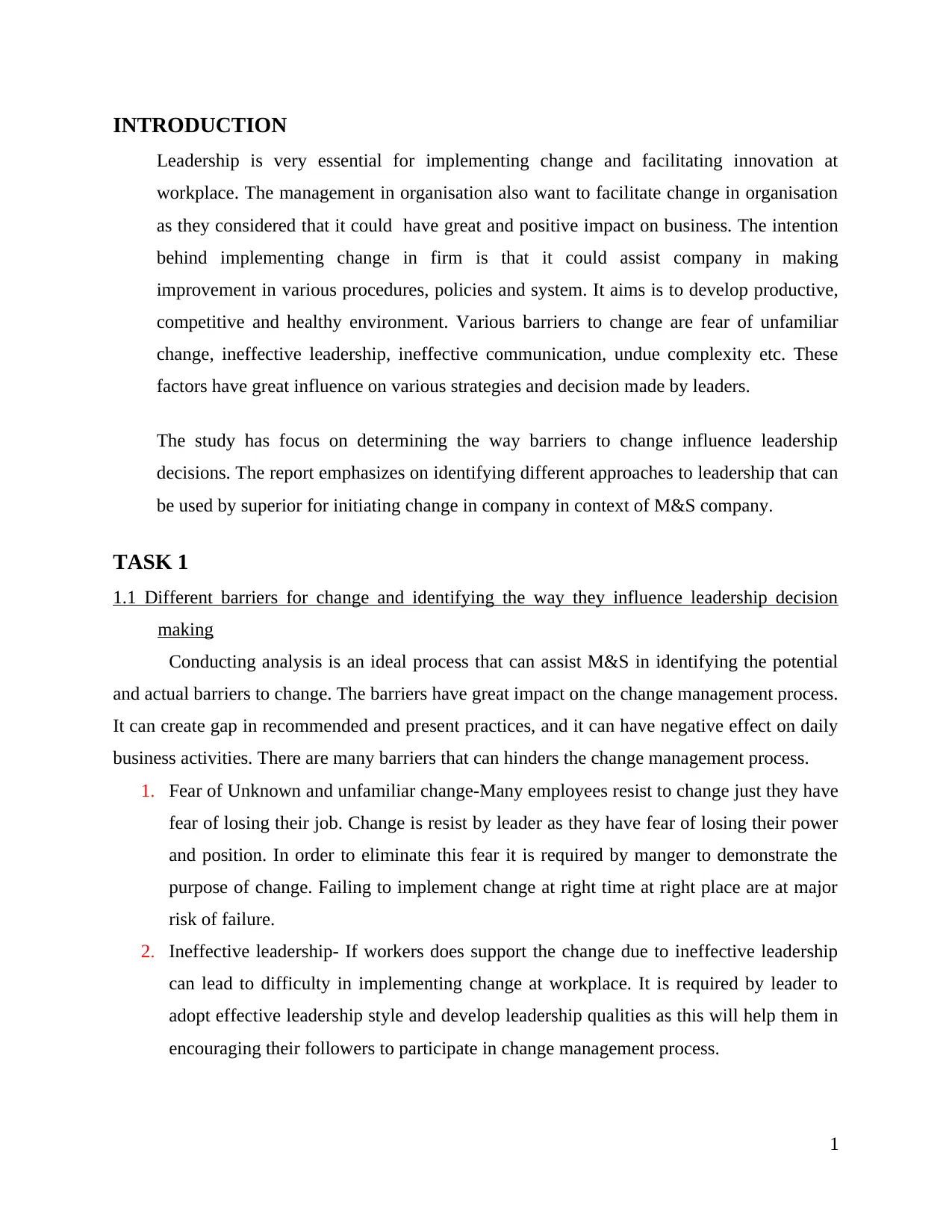
INTRODUCTION
Leadership is very essential for implementing change and facilitating innovation at
workplace. The management in organisation also want to facilitate change in organisation
as they considered that it could have great and positive impact on business. The intention
behind implementing change in firm is that it could assist company in making
improvement in various procedures, policies and system. It aims is to develop productive,
competitive and healthy environment. Various barriers to change are fear of unfamiliar
change, ineffective leadership, ineffective communication, undue complexity etc. These
factors have great influence on various strategies and decision made by leaders.
The study has focus on determining the way barriers to change influence leadership
decisions. The report emphasizes on identifying different approaches to leadership that can
be used by superior for initiating change in company in context of M&S company.
TASK 1
1.1 Different barriers for change and identifying the way they influence leadership decision
making
Conducting analysis is an ideal process that can assist M&S in identifying the potential
and actual barriers to change. The barriers have great impact on the change management process.
It can create gap in recommended and present practices, and it can have negative effect on daily
business activities. There are many barriers that can hinders the change management process.
1. Fear of Unknown and unfamiliar change-Many employees resist to change just they have
fear of losing their job. Change is resist by leader as they have fear of losing their power
and position. In order to eliminate this fear it is required by manger to demonstrate the
purpose of change. Failing to implement change at right time at right place are at major
risk of failure.
2. Ineffective leadership- If workers does support the change due to ineffective leadership
can lead to difficulty in implementing change at workplace. It is required by leader to
adopt effective leadership style and develop leadership qualities as this will help them in
encouraging their followers to participate in change management process.
1
Leadership is very essential for implementing change and facilitating innovation at
workplace. The management in organisation also want to facilitate change in organisation
as they considered that it could have great and positive impact on business. The intention
behind implementing change in firm is that it could assist company in making
improvement in various procedures, policies and system. It aims is to develop productive,
competitive and healthy environment. Various barriers to change are fear of unfamiliar
change, ineffective leadership, ineffective communication, undue complexity etc. These
factors have great influence on various strategies and decision made by leaders.
The study has focus on determining the way barriers to change influence leadership
decisions. The report emphasizes on identifying different approaches to leadership that can
be used by superior for initiating change in company in context of M&S company.
TASK 1
1.1 Different barriers for change and identifying the way they influence leadership decision
making
Conducting analysis is an ideal process that can assist M&S in identifying the potential
and actual barriers to change. The barriers have great impact on the change management process.
It can create gap in recommended and present practices, and it can have negative effect on daily
business activities. There are many barriers that can hinders the change management process.
1. Fear of Unknown and unfamiliar change-Many employees resist to change just they have
fear of losing their job. Change is resist by leader as they have fear of losing their power
and position. In order to eliminate this fear it is required by manger to demonstrate the
purpose of change. Failing to implement change at right time at right place are at major
risk of failure.
2. Ineffective leadership- If workers does support the change due to ineffective leadership
can lead to difficulty in implementing change at workplace. It is required by leader to
adopt effective leadership style and develop leadership qualities as this will help them in
encouraging their followers to participate in change management process.
1
Paraphrase This Document
Need a fresh take? Get an instant paraphrase of this document with our AI Paraphraser
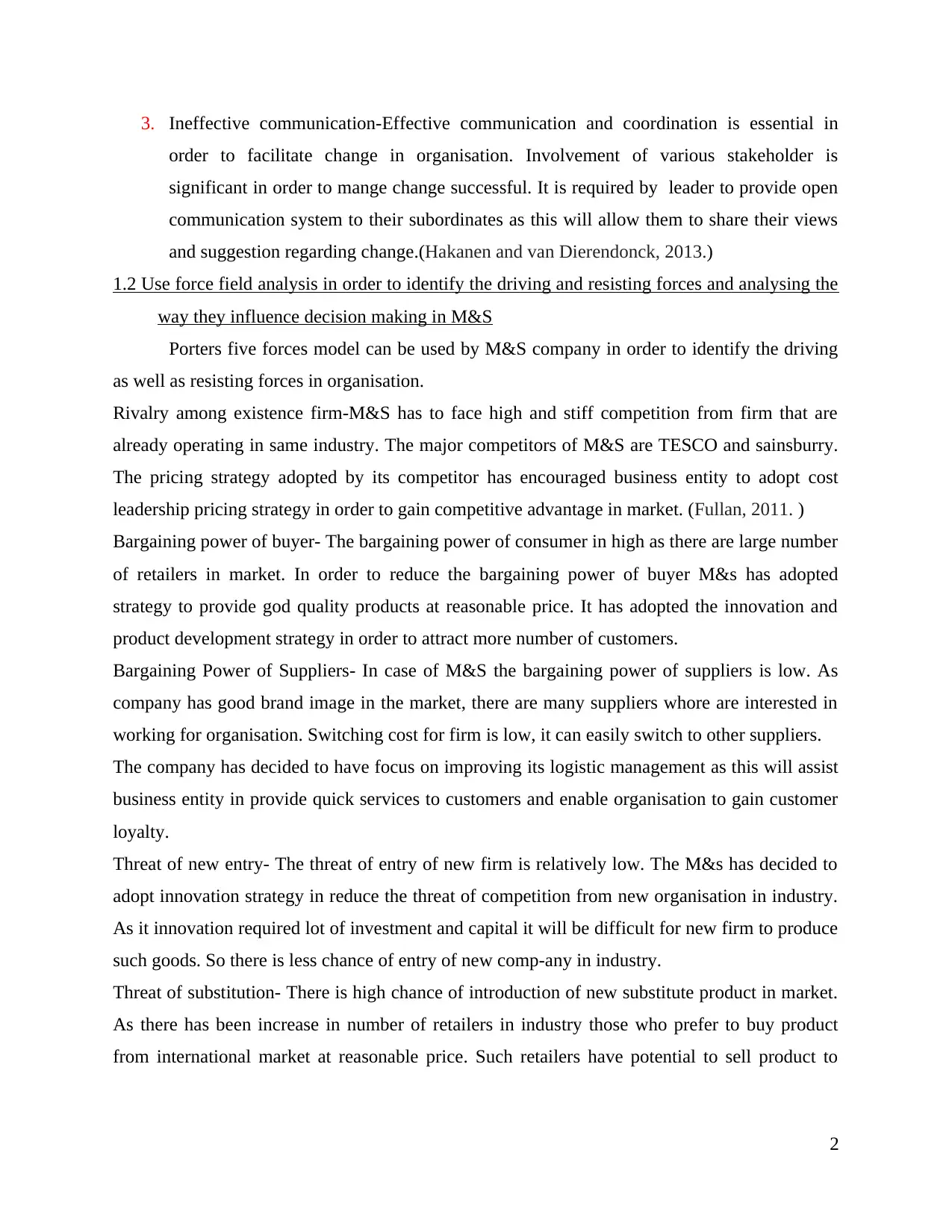
3. Ineffective communication-Effective communication and coordination is essential in
order to facilitate change in organisation. Involvement of various stakeholder is
significant in order to mange change successful. It is required by leader to provide open
communication system to their subordinates as this will allow them to share their views
and suggestion regarding change.(Hakanen and van Dierendonck, 2013.)
1.2 Use force field analysis in order to identify the driving and resisting forces and analysing the
way they influence decision making in M&S
Porters five forces model can be used by M&S company in order to identify the driving
as well as resisting forces in organisation.
Rivalry among existence firm-M&S has to face high and stiff competition from firm that are
already operating in same industry. The major competitors of M&S are TESCO and sainsburry.
The pricing strategy adopted by its competitor has encouraged business entity to adopt cost
leadership pricing strategy in order to gain competitive advantage in market. (Fullan, 2011. )
Bargaining power of buyer- The bargaining power of consumer in high as there are large number
of retailers in market. In order to reduce the bargaining power of buyer M&s has adopted
strategy to provide god quality products at reasonable price. It has adopted the innovation and
product development strategy in order to attract more number of customers.
Bargaining Power of Suppliers- In case of M&S the bargaining power of suppliers is low. As
company has good brand image in the market, there are many suppliers whore are interested in
working for organisation. Switching cost for firm is low, it can easily switch to other suppliers.
The company has decided to have focus on improving its logistic management as this will assist
business entity in provide quick services to customers and enable organisation to gain customer
loyalty.
Threat of new entry- The threat of entry of new firm is relatively low. The M&s has decided to
adopt innovation strategy in reduce the threat of competition from new organisation in industry.
As it innovation required lot of investment and capital it will be difficult for new firm to produce
such goods. So there is less chance of entry of new comp-any in industry.
Threat of substitution- There is high chance of introduction of new substitute product in market.
As there has been increase in number of retailers in industry those who prefer to buy product
from international market at reasonable price. Such retailers have potential to sell product to
2
order to facilitate change in organisation. Involvement of various stakeholder is
significant in order to mange change successful. It is required by leader to provide open
communication system to their subordinates as this will allow them to share their views
and suggestion regarding change.(Hakanen and van Dierendonck, 2013.)
1.2 Use force field analysis in order to identify the driving and resisting forces and analysing the
way they influence decision making in M&S
Porters five forces model can be used by M&S company in order to identify the driving
as well as resisting forces in organisation.
Rivalry among existence firm-M&S has to face high and stiff competition from firm that are
already operating in same industry. The major competitors of M&S are TESCO and sainsburry.
The pricing strategy adopted by its competitor has encouraged business entity to adopt cost
leadership pricing strategy in order to gain competitive advantage in market. (Fullan, 2011. )
Bargaining power of buyer- The bargaining power of consumer in high as there are large number
of retailers in market. In order to reduce the bargaining power of buyer M&s has adopted
strategy to provide god quality products at reasonable price. It has adopted the innovation and
product development strategy in order to attract more number of customers.
Bargaining Power of Suppliers- In case of M&S the bargaining power of suppliers is low. As
company has good brand image in the market, there are many suppliers whore are interested in
working for organisation. Switching cost for firm is low, it can easily switch to other suppliers.
The company has decided to have focus on improving its logistic management as this will assist
business entity in provide quick services to customers and enable organisation to gain customer
loyalty.
Threat of new entry- The threat of entry of new firm is relatively low. The M&s has decided to
adopt innovation strategy in reduce the threat of competition from new organisation in industry.
As it innovation required lot of investment and capital it will be difficult for new firm to produce
such goods. So there is less chance of entry of new comp-any in industry.
Threat of substitution- There is high chance of introduction of new substitute product in market.
As there has been increase in number of retailers in industry those who prefer to buy product
from international market at reasonable price. Such retailers have potential to sell product to
2
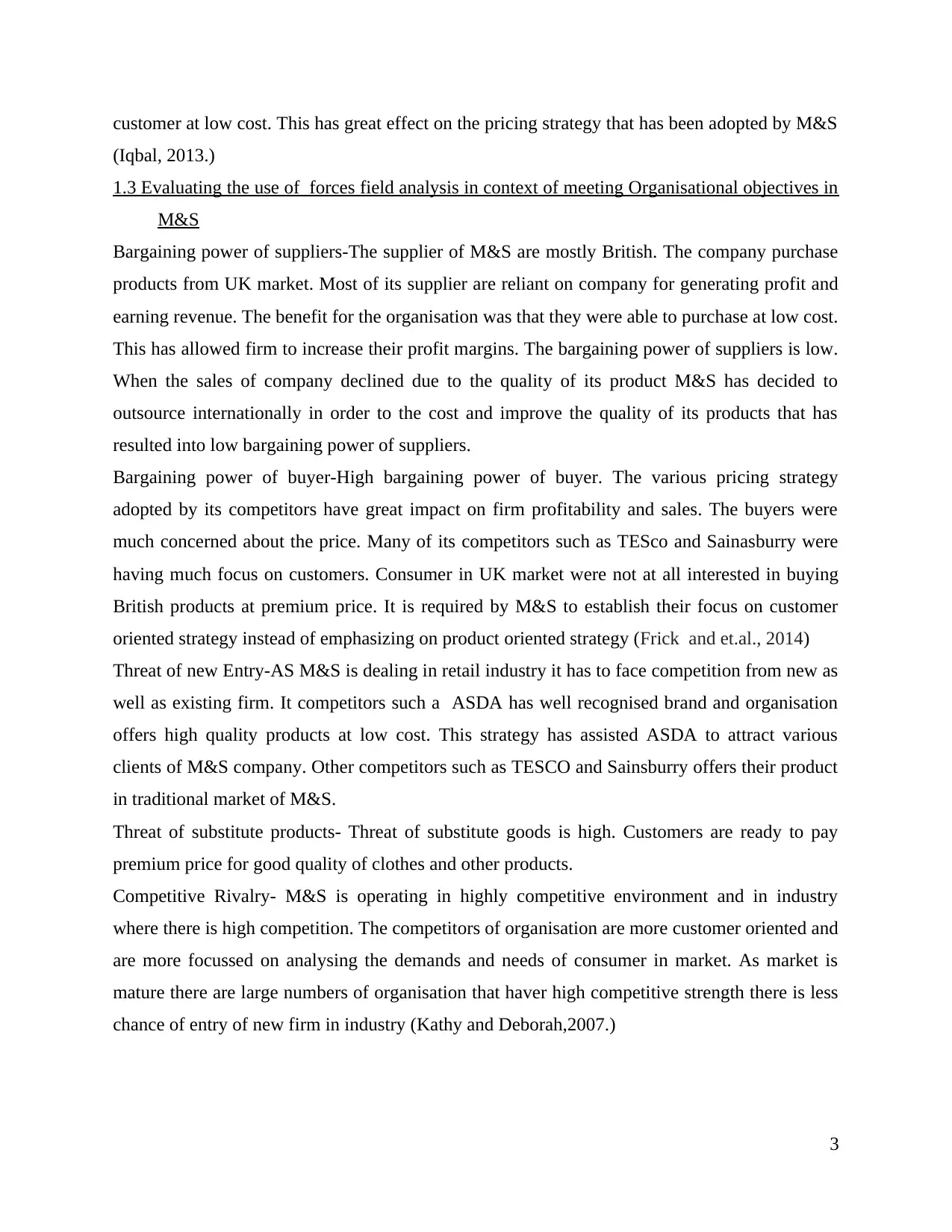
customer at low cost. This has great effect on the pricing strategy that has been adopted by M&S
(Iqbal, 2013.)
1.3 Evaluating the use of forces field analysis in context of meeting Organisational objectives in
M&S
Bargaining power of suppliers-The supplier of M&S are mostly British. The company purchase
products from UK market. Most of its supplier are reliant on company for generating profit and
earning revenue. The benefit for the organisation was that they were able to purchase at low cost.
This has allowed firm to increase their profit margins. The bargaining power of suppliers is low.
When the sales of company declined due to the quality of its product M&S has decided to
outsource internationally in order to the cost and improve the quality of its products that has
resulted into low bargaining power of suppliers.
Bargaining power of buyer-High bargaining power of buyer. The various pricing strategy
adopted by its competitors have great impact on firm profitability and sales. The buyers were
much concerned about the price. Many of its competitors such as TESco and Sainasburry were
having much focus on customers. Consumer in UK market were not at all interested in buying
British products at premium price. It is required by M&S to establish their focus on customer
oriented strategy instead of emphasizing on product oriented strategy (Frick and et.al., 2014)
Threat of new Entry-AS M&S is dealing in retail industry it has to face competition from new as
well as existing firm. It competitors such a ASDA has well recognised brand and organisation
offers high quality products at low cost. This strategy has assisted ASDA to attract various
clients of M&S company. Other competitors such as TESCO and Sainsburry offers their product
in traditional market of M&S.
Threat of substitute products- Threat of substitute goods is high. Customers are ready to pay
premium price for good quality of clothes and other products.
Competitive Rivalry- M&S is operating in highly competitive environment and in industry
where there is high competition. The competitors of organisation are more customer oriented and
are more focussed on analysing the demands and needs of consumer in market. As market is
mature there are large numbers of organisation that haver high competitive strength there is less
chance of entry of new firm in industry (Kathy and Deborah,2007.)
3
(Iqbal, 2013.)
1.3 Evaluating the use of forces field analysis in context of meeting Organisational objectives in
M&S
Bargaining power of suppliers-The supplier of M&S are mostly British. The company purchase
products from UK market. Most of its supplier are reliant on company for generating profit and
earning revenue. The benefit for the organisation was that they were able to purchase at low cost.
This has allowed firm to increase their profit margins. The bargaining power of suppliers is low.
When the sales of company declined due to the quality of its product M&S has decided to
outsource internationally in order to the cost and improve the quality of its products that has
resulted into low bargaining power of suppliers.
Bargaining power of buyer-High bargaining power of buyer. The various pricing strategy
adopted by its competitors have great impact on firm profitability and sales. The buyers were
much concerned about the price. Many of its competitors such as TESco and Sainasburry were
having much focus on customers. Consumer in UK market were not at all interested in buying
British products at premium price. It is required by M&S to establish their focus on customer
oriented strategy instead of emphasizing on product oriented strategy (Frick and et.al., 2014)
Threat of new Entry-AS M&S is dealing in retail industry it has to face competition from new as
well as existing firm. It competitors such a ASDA has well recognised brand and organisation
offers high quality products at low cost. This strategy has assisted ASDA to attract various
clients of M&S company. Other competitors such as TESCO and Sainsburry offers their product
in traditional market of M&S.
Threat of substitute products- Threat of substitute goods is high. Customers are ready to pay
premium price for good quality of clothes and other products.
Competitive Rivalry- M&S is operating in highly competitive environment and in industry
where there is high competition. The competitors of organisation are more customer oriented and
are more focussed on analysing the demands and needs of consumer in market. As market is
mature there are large numbers of organisation that haver high competitive strength there is less
chance of entry of new firm in industry (Kathy and Deborah,2007.)
3
⊘ This is a preview!⊘
Do you want full access?
Subscribe today to unlock all pages.

Trusted by 1+ million students worldwide
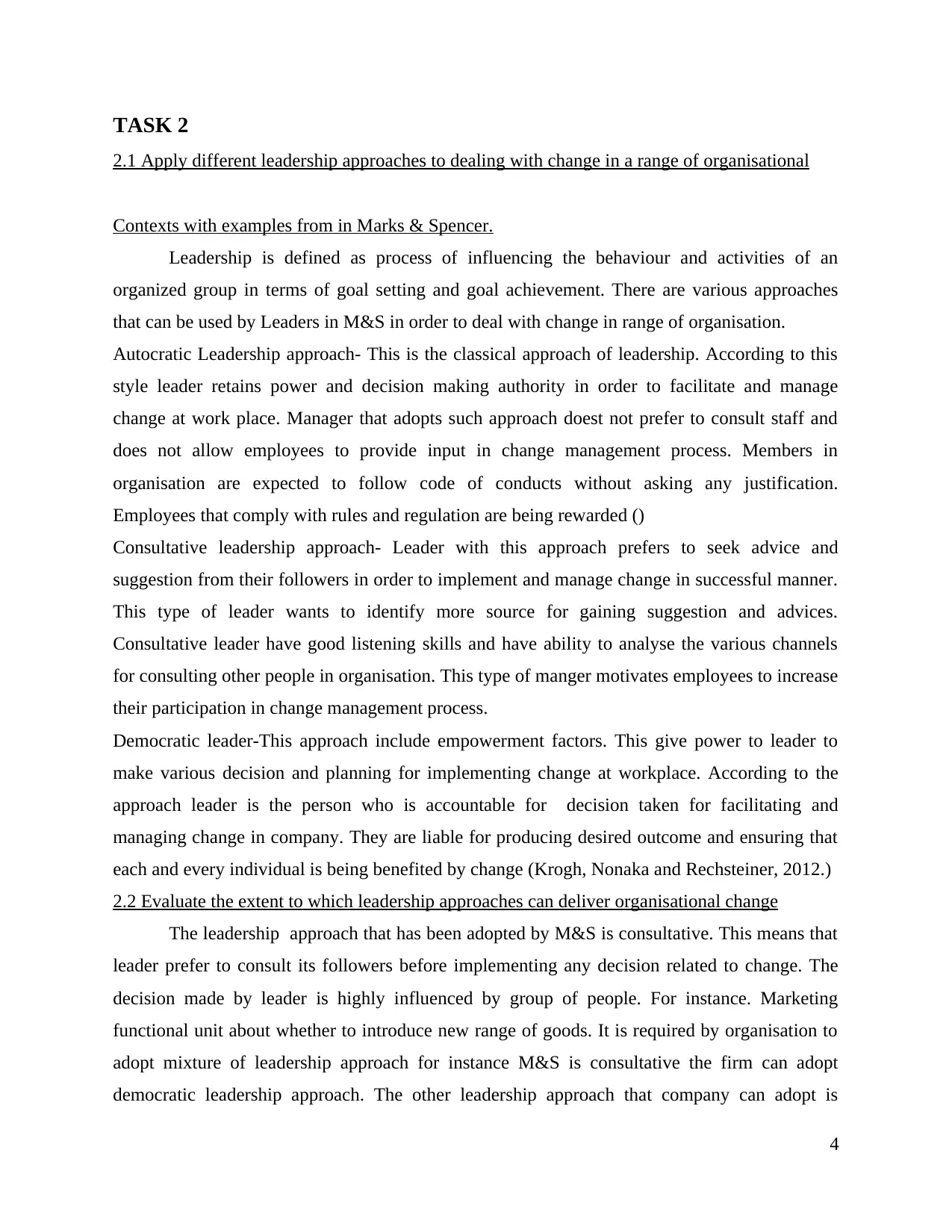
TASK 2
2.1 Apply different leadership approaches to dealing with change in a range of organisational
Contexts with examples from in Marks & Spencer.
Leadership is defined as process of influencing the behaviour and activities of an
organized group in terms of goal setting and goal achievement. There are various approaches
that can be used by Leaders in M&S in order to deal with change in range of organisation.
Autocratic Leadership approach- This is the classical approach of leadership. According to this
style leader retains power and decision making authority in order to facilitate and manage
change at work place. Manager that adopts such approach doest not prefer to consult staff and
does not allow employees to provide input in change management process. Members in
organisation are expected to follow code of conducts without asking any justification.
Employees that comply with rules and regulation are being rewarded ()
Consultative leadership approach- Leader with this approach prefers to seek advice and
suggestion from their followers in order to implement and manage change in successful manner.
This type of leader wants to identify more source for gaining suggestion and advices.
Consultative leader have good listening skills and have ability to analyse the various channels
for consulting other people in organisation. This type of manger motivates employees to increase
their participation in change management process.
Democratic leader-This approach include empowerment factors. This give power to leader to
make various decision and planning for implementing change at workplace. According to the
approach leader is the person who is accountable for decision taken for facilitating and
managing change in company. They are liable for producing desired outcome and ensuring that
each and every individual is being benefited by change (Krogh, Nonaka and Rechsteiner, 2012.)
2.2 Evaluate the extent to which leadership approaches can deliver organisational change
The leadership approach that has been adopted by M&S is consultative. This means that
leader prefer to consult its followers before implementing any decision related to change. The
decision made by leader is highly influenced by group of people. For instance. Marketing
functional unit about whether to introduce new range of goods. It is required by organisation to
adopt mixture of leadership approach for instance M&S is consultative the firm can adopt
democratic leadership approach. The other leadership approach that company can adopt is
4
2.1 Apply different leadership approaches to dealing with change in a range of organisational
Contexts with examples from in Marks & Spencer.
Leadership is defined as process of influencing the behaviour and activities of an
organized group in terms of goal setting and goal achievement. There are various approaches
that can be used by Leaders in M&S in order to deal with change in range of organisation.
Autocratic Leadership approach- This is the classical approach of leadership. According to this
style leader retains power and decision making authority in order to facilitate and manage
change at work place. Manager that adopts such approach doest not prefer to consult staff and
does not allow employees to provide input in change management process. Members in
organisation are expected to follow code of conducts without asking any justification.
Employees that comply with rules and regulation are being rewarded ()
Consultative leadership approach- Leader with this approach prefers to seek advice and
suggestion from their followers in order to implement and manage change in successful manner.
This type of leader wants to identify more source for gaining suggestion and advices.
Consultative leader have good listening skills and have ability to analyse the various channels
for consulting other people in organisation. This type of manger motivates employees to increase
their participation in change management process.
Democratic leader-This approach include empowerment factors. This give power to leader to
make various decision and planning for implementing change at workplace. According to the
approach leader is the person who is accountable for decision taken for facilitating and
managing change in company. They are liable for producing desired outcome and ensuring that
each and every individual is being benefited by change (Krogh, Nonaka and Rechsteiner, 2012.)
2.2 Evaluate the extent to which leadership approaches can deliver organisational change
The leadership approach that has been adopted by M&S is consultative. This means that
leader prefer to consult its followers before implementing any decision related to change. The
decision made by leader is highly influenced by group of people. For instance. Marketing
functional unit about whether to introduce new range of goods. It is required by organisation to
adopt mixture of leadership approach for instance M&S is consultative the firm can adopt
democratic leadership approach. The other leadership approach that company can adopt is
4
Paraphrase This Document
Need a fresh take? Get an instant paraphrase of this document with our AI Paraphraser
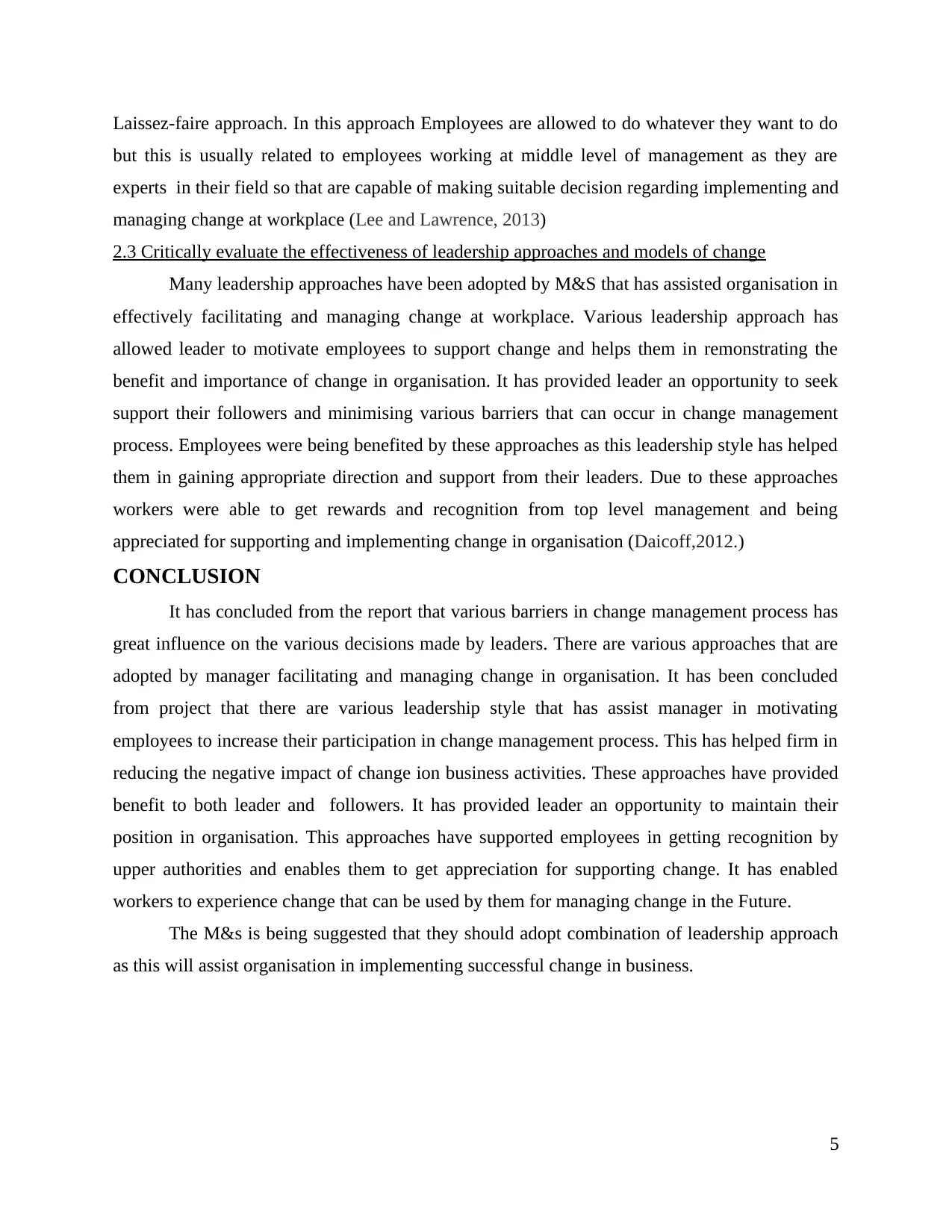
Laissez-faire approach. In this approach Employees are allowed to do whatever they want to do
but this is usually related to employees working at middle level of management as they are
experts in their field so that are capable of making suitable decision regarding implementing and
managing change at workplace (Lee and Lawrence, 2013)
2.3 Critically evaluate the effectiveness of leadership approaches and models of change
Many leadership approaches have been adopted by M&S that has assisted organisation in
effectively facilitating and managing change at workplace. Various leadership approach has
allowed leader to motivate employees to support change and helps them in remonstrating the
benefit and importance of change in organisation. It has provided leader an opportunity to seek
support their followers and minimising various barriers that can occur in change management
process. Employees were being benefited by these approaches as this leadership style has helped
them in gaining appropriate direction and support from their leaders. Due to these approaches
workers were able to get rewards and recognition from top level management and being
appreciated for supporting and implementing change in organisation (Daicoff,2012.)
CONCLUSION
It has concluded from the report that various barriers in change management process has
great influence on the various decisions made by leaders. There are various approaches that are
adopted by manager facilitating and managing change in organisation. It has been concluded
from project that there are various leadership style that has assist manager in motivating
employees to increase their participation in change management process. This has helped firm in
reducing the negative impact of change ion business activities. These approaches have provided
benefit to both leader and followers. It has provided leader an opportunity to maintain their
position in organisation. This approaches have supported employees in getting recognition by
upper authorities and enables them to get appreciation for supporting change. It has enabled
workers to experience change that can be used by them for managing change in the Future.
The M&s is being suggested that they should adopt combination of leadership approach
as this will assist organisation in implementing successful change in business.
5
but this is usually related to employees working at middle level of management as they are
experts in their field so that are capable of making suitable decision regarding implementing and
managing change at workplace (Lee and Lawrence, 2013)
2.3 Critically evaluate the effectiveness of leadership approaches and models of change
Many leadership approaches have been adopted by M&S that has assisted organisation in
effectively facilitating and managing change at workplace. Various leadership approach has
allowed leader to motivate employees to support change and helps them in remonstrating the
benefit and importance of change in organisation. It has provided leader an opportunity to seek
support their followers and minimising various barriers that can occur in change management
process. Employees were being benefited by these approaches as this leadership style has helped
them in gaining appropriate direction and support from their leaders. Due to these approaches
workers were able to get rewards and recognition from top level management and being
appreciated for supporting and implementing change in organisation (Daicoff,2012.)
CONCLUSION
It has concluded from the report that various barriers in change management process has
great influence on the various decisions made by leaders. There are various approaches that are
adopted by manager facilitating and managing change in organisation. It has been concluded
from project that there are various leadership style that has assist manager in motivating
employees to increase their participation in change management process. This has helped firm in
reducing the negative impact of change ion business activities. These approaches have provided
benefit to both leader and followers. It has provided leader an opportunity to maintain their
position in organisation. This approaches have supported employees in getting recognition by
upper authorities and enables them to get appreciation for supporting change. It has enabled
workers to experience change that can be used by them for managing change in the Future.
The M&s is being suggested that they should adopt combination of leadership approach
as this will assist organisation in implementing successful change in business.
5
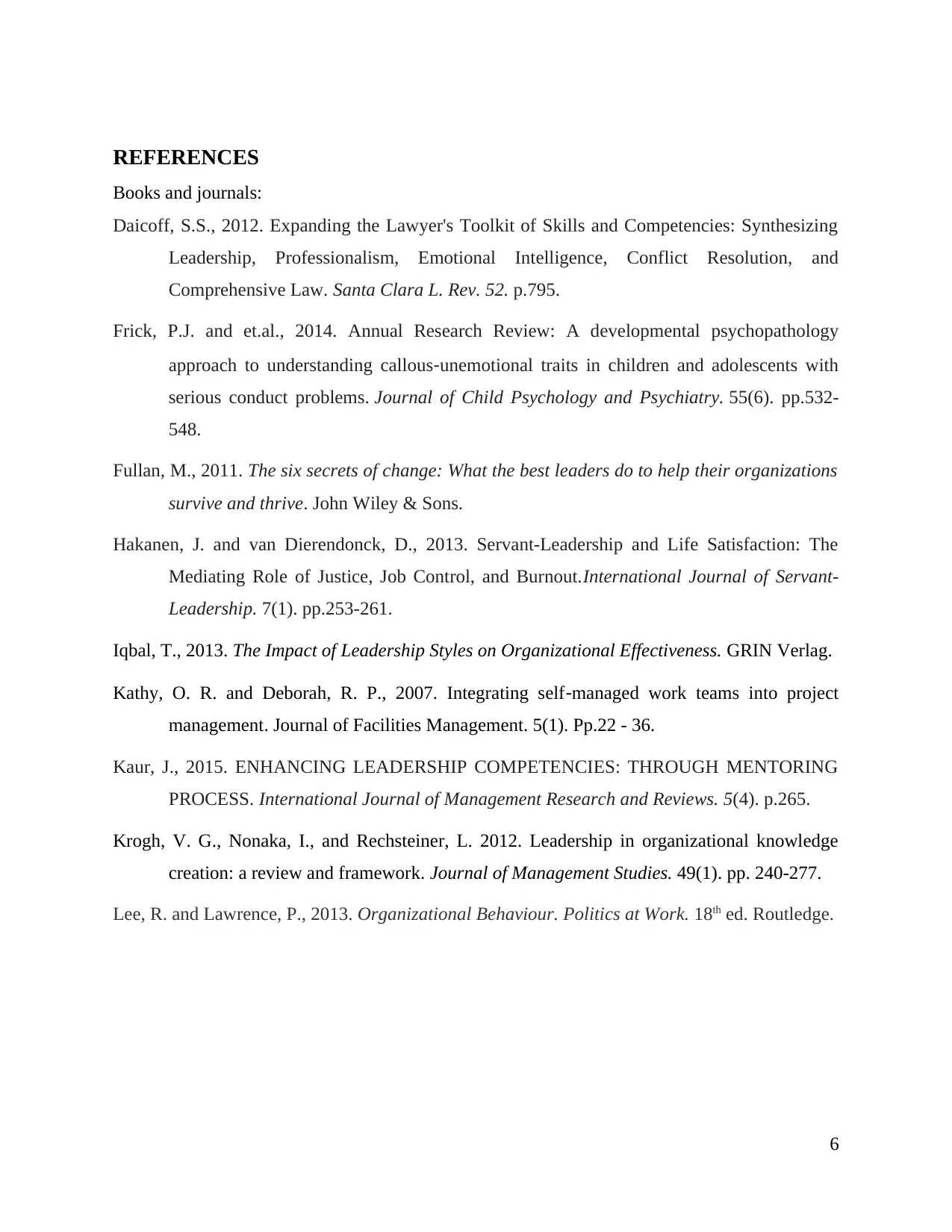
REFERENCES
Books and journals:
Daicoff, S.S., 2012. Expanding the Lawyer's Toolkit of Skills and Competencies: Synthesizing
Leadership, Professionalism, Emotional Intelligence, Conflict Resolution, and
Comprehensive Law. Santa Clara L. Rev. 52. p.795.
Frick, P.J. and et.al., 2014. Annual Research Review: A developmental psychopathology
approach to understanding callous‐unemotional traits in children and adolescents with
serious conduct problems. Journal of Child Psychology and Psychiatry. 55(6). pp.532-
548.
Fullan, M., 2011. The six secrets of change: What the best leaders do to help their organizations
survive and thrive. John Wiley & Sons.
Hakanen, J. and van Dierendonck, D., 2013. Servant-Leadership and Life Satisfaction: The
Mediating Role of Justice, Job Control, and Burnout.International Journal of Servant-
Leadership. 7(1). pp.253-261.
Iqbal, T., 2013. The Impact of Leadership Styles on Organizational Effectiveness. GRIN Verlag.
Kathy, O. R. and Deborah, R. P., 2007. Integrating self‐managed work teams into project
management. Journal of Facilities Management. 5(1). Pp.22 - 36.
Kaur, J., 2015. ENHANCING LEADERSHIP COMPETENCIES: THROUGH MENTORING
PROCESS. International Journal of Management Research and Reviews. 5(4). p.265.
Krogh, V. G., Nonaka, I., and Rechsteiner, L. 2012. Leadership in organizational knowledge
creation: a review and framework. Journal of Management Studies. 49(1). pp. 240-277.
Lee, R. and Lawrence, P., 2013. Organizational Behaviour. Politics at Work. 18th ed. Routledge.
6
Books and journals:
Daicoff, S.S., 2012. Expanding the Lawyer's Toolkit of Skills and Competencies: Synthesizing
Leadership, Professionalism, Emotional Intelligence, Conflict Resolution, and
Comprehensive Law. Santa Clara L. Rev. 52. p.795.
Frick, P.J. and et.al., 2014. Annual Research Review: A developmental psychopathology
approach to understanding callous‐unemotional traits in children and adolescents with
serious conduct problems. Journal of Child Psychology and Psychiatry. 55(6). pp.532-
548.
Fullan, M., 2011. The six secrets of change: What the best leaders do to help their organizations
survive and thrive. John Wiley & Sons.
Hakanen, J. and van Dierendonck, D., 2013. Servant-Leadership and Life Satisfaction: The
Mediating Role of Justice, Job Control, and Burnout.International Journal of Servant-
Leadership. 7(1). pp.253-261.
Iqbal, T., 2013. The Impact of Leadership Styles on Organizational Effectiveness. GRIN Verlag.
Kathy, O. R. and Deborah, R. P., 2007. Integrating self‐managed work teams into project
management. Journal of Facilities Management. 5(1). Pp.22 - 36.
Kaur, J., 2015. ENHANCING LEADERSHIP COMPETENCIES: THROUGH MENTORING
PROCESS. International Journal of Management Research and Reviews. 5(4). p.265.
Krogh, V. G., Nonaka, I., and Rechsteiner, L. 2012. Leadership in organizational knowledge
creation: a review and framework. Journal of Management Studies. 49(1). pp. 240-277.
Lee, R. and Lawrence, P., 2013. Organizational Behaviour. Politics at Work. 18th ed. Routledge.
6
⊘ This is a preview!⊘
Do you want full access?
Subscribe today to unlock all pages.

Trusted by 1+ million students worldwide
1 out of 9
Related Documents
Your All-in-One AI-Powered Toolkit for Academic Success.
+13062052269
info@desklib.com
Available 24*7 on WhatsApp / Email
![[object Object]](/_next/static/media/star-bottom.7253800d.svg)
Unlock your academic potential
Copyright © 2020–2025 A2Z Services. All Rights Reserved. Developed and managed by ZUCOL.


